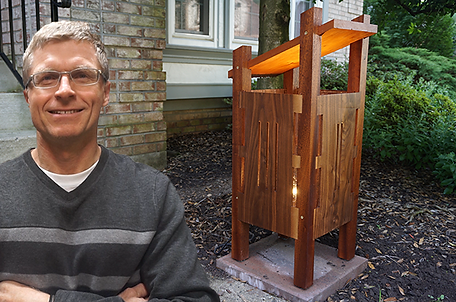Contemporary Outdoor Lights

These lamps are my own design, but probably inspired by some of the work of Frank Lloyd Wright.
The posts in the corner are made from Sipo. I was originally going to make them from Spanish Cedar, but my local wood dealer didn't have any that was thick enough. Next time....
The grilles are made from 1/4" walnut.
The angled top is made from Spanish cedar. Its lighter color is a good choice to reflect the light.

I cut the Sipo to a rough length of 30" for the posts at the front and 36" for the posts at the back. This would be long enough to accommodate a 30 degree angle for the top. (I ended up chaning the angle to 20 degrees)
Sipo is an African wood, also known as Utile. It has characteristics similar to the Mahogany that we get from South America, but it's less expensive. This will hold up well to the outdoor weather.

On the band saw, I cut the legs to be a little over 2" wide, with the goal of having the final legs planed to be 2" square.

I used some leftover walnut that was 8/4" thick and about 10.5" wide.
I used the band saw to re-saw it to almost 1/2" thick so that the final planed dimension would be 1/4".
I could definitely feel the saw working. It would have been easier if I had a carbide blade. In this case I used a regular 1/2" blade that was fairly new.

I planed the walnut down to 1/4" thick and then cut it to width -- about 10" wide.

Using a 3/8" spiral up-cut bit in the router, with stops attached to the ends of the router table, I routed three vertical slots into the walnut. These slots would allow the light to shine through.

I used my dado set to cut notches in the side. This would create one more slot for the light to escape. It would also create 3 tabs on each side that would attach to the corner posts.
You may have noticed that this grille has only two slots cut into it. That's because I made a mistake and cut the first slot in the wrong place. I was able to recover by adjusting this design.
I purposely made two pieces like this to go onto the back of each lamp. But then I made a mistake again and forgot about this design change. When doing the assembly, I accidentally put one of the grills with two slots onto the front of one of the lamps. Ooops!!

I cut 20 degree dadoes near the top of each post to hold the Spanish cedar top in place. The angle serves two purposes: it allows the rainfall to run off the top; and it provides a nice reflective surface for the LED light to reflect outwards.
I also cut 90 degree dadoes for the bottom board. The bottom is used to hold the LED light in place.
I used blue tape on the posts to help prevent tear-out.

I cut a 1 3/4" hole in the bottom board using a Forstner bit. It's a perfect size to hold the LED light in place. It's held in place just with gravity.

I used a knife to score the acrylic sheet. This will be inserted into slots in the legs to help protect against the weather.

I used a 1/8" router bit to cut slots into the legs to hold the acrylic sheets.
The acrylic was 0.110" and the bit was 0.125", so it was perfect.
I ran the router on the slowest speed and was very careful because it's easy to break a router bit that is so thin.

I applied a spar urethane to the inside of each of the grilles. This was an important because it will be impossible to apply finish after it's assembled due to the acrylic sheets that block access to the inside of the walnut.

I carefully marked the mortises for the walnut tabs using a knife and a chisel.
Then I used the router with a 3/8" spiral up-cut bit to cut the mortises for the walnut tabs. I cleaned up the mortises with a chisel and end up with a tight fit.

It took me about 30 minutes to prepare the mortises for each side. Then I glued and clamped the walnut in place.
I was a little aggressive and left them clamped for only 30 minutes while I prepared the next side, and then removed the clamps so that I could clamp up the next side.
Then I let everything sit overnight so that the glue could cure.

I am setting the lamps on top of patio stones so that the legs will not be in direct contact with the soil.
I first drilled holes into the corners of the patio stones (after marking the position of each leg).
Then I set the lamps in place and drilled a 1/4" hole up into the legs.
I used 3 1/2" 1/4" bolts that extend from the bottom of the patio stone into each leg. There is a nut that holds the bolt in place, and it also maintains separation between the wooden leg and the patio stone.

The lamps are wired into the 12V landscape lighting wire that I already had in place, so that was the simplest part of this project.
I am really happy with the design and the way the light reflects off the Spanish cedar.

Watch the video here!



